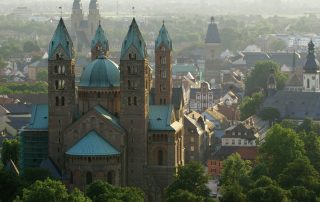
Speyer Cathedral
The imperial cathedral in Speyer, officially known as the Cathedral of St. Mary and St. Stephen, is the town's most prominent landmark. Laid out in the form of a Latin cross, it is one of Germany's largest and most important Romanesque buildings, and was intended to be no less than the largest church in the western world when building work began in 1030.
Speyer Cathedral in the Rhineland-Palatinate region has long since ceased to be the largest church in the western world. However, it is still the world's largest surviving Romanesque church. Construction began under Salian Emperor Konrad II, and the church was consecrated in 1061 under his grandson Heinrich IV. Its huge triple-naved vaulted basilica is the central element of a design that is thought to have greatly influenced Romanesque architecture in the 11th and 12th century. The mighty but eminently well-proportioned main building, consisting of the nave and transept with four towers in a symmetrical design, inspired many other important churches. A central attraction that strongly reflects the spirit of the time is the fully preserved crypt, which is the largest Romanesque columned hall in Europe.
As the burial site for Salian, Hohenstaufen and Habsburg rulers and their wives, the crypt – and the cathedral itself – represent the ultimate symbol of medieval imperial power. The huge 'cathedral bowl' outside the main door is certainly worth a visit. With a capacity of 1,560 litres, it had to be filled with wine by every new bishop to keep the people happy. Perhaps these are the origins of the Cathedral Wine Fair in spring at which Palatinate vineyards present their wines against the stunning backdrop of the cathedral. Every year in September and October, the International Music Festival is held at Speyer Cathedral. It features concerts by choirs and orchestras, as well as organ recitals.
Speyer Cathedral
UNESCO World Heritage since 1981
From the selection criteria
Information and Contact
Tourist-Information Speyer
Maximilianstraße 13
67346 Speyer
Tel. +49 6232-14 23 92






